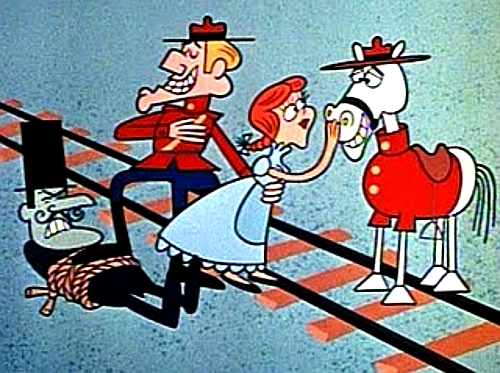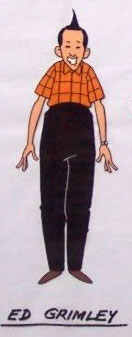
The Biography of Dudley Do-Right. The long extinct Dudley Do-Right Emporium (1971-2005) that was open on a whimsical limited basis whenever they felt like it on Sunset Boulevard had a plethora of oddball items for sale including actual coconuts that could be addressed and mailed to people, xeroxed cartoon storyboards, matted cels, character wristwatches, t-shirts and items that seem to have been produced just to amuse the staff of the Jay Ward Studio.
One such thing was a one page single-sided handout of a personal biography of Dudley Do-Right. Here is an excerpt from that document that included a sketch drawing of Dudley on his horse chasing down a scared old lady running away as he grimly shouted “Jaywalker!”
“Born in Toronto, where his daddy was a well-to-do chick-pea distributor, young Dudley attended the DeLacey School of Good Conduct and Decorum, where he was a three-time winner of Fauntleroy Exemplary Behavior Award and was affectionately known to his classmates as ‘Fink’ Do-Right. He later attended McGill University where he majored in Personal Hygiene and minored in Good-Citizenship.
“A stickler for regulation, Dudley is the only Mountie known to starch his underwear and socks and to adjust his hat with a plumb bob and mason’s level. As a law-enforcer, he has been known to jail a pregnant spaniel for violating the anti-litter law.”
 Ed Grimley. Animator Jon McClenahan, founder of Star Toons animation studio, had a variety of jobs in the business. In an interview with Platypus Comix, he talked about working on the storyboards for The Completely Mental Misaventures of Ed Grimley.
Ed Grimley. Animator Jon McClenahan, founder of Star Toons animation studio, had a variety of jobs in the business. In an interview with Platypus Comix, he talked about working on the storyboards for The Completely Mental Misaventures of Ed Grimley.
“Bill Hanna put me in touch with Kay Wright who was one of his producers. Kay was working with Scott Shaw! on a new series called ‘The Completely Mental Misadventures of Ed Grimley’. They needed storyboard artists. Having been in Australia throughout the 80’s, I had no idea who Ed Grimley or Martin Short was, but the scripts were hilarious – very quirky, which I loved.
“I had never done storyboards back at Hanna-Barbera (in Australia), but I didn’t tell Kay that. Scott Shaw! would check my boards, and at first I had a lot of corrections to do, but they liked my style.
“Sometimes I’d receive home video tapes of Martin Short describing what he was looking for in a script, and he would act everything out. Those were fun to watch and really inspiring … although sometimes I’d ignore them. I might have one or two of the Short tapes stuck away somewhere in my attic. Some day after I die, people will probably find a buncha interesting old stuff up there.”
 Belle. Songwriter Alan Menken remembered for Entertainment Weekly magazine (January 23, 2015) writing the iconic song “Belle” for the Disney animated feature “Beauty and the Beast” (1991): “The story behind this is that Howard Ashman was HIV-positive and wasn’t telling anybody. He had been very quiet. And here we had written this crazy seven-minute opening number that was more more ambitious than anybody had asked for, and I remember his fear (about everything) in that moment.
Belle. Songwriter Alan Menken remembered for Entertainment Weekly magazine (January 23, 2015) writing the iconic song “Belle” for the Disney animated feature “Beauty and the Beast” (1991): “The story behind this is that Howard Ashman was HIV-positive and wasn’t telling anybody. He had been very quiet. And here we had written this crazy seven-minute opening number that was more more ambitious than anybody had asked for, and I remember his fear (about everything) in that moment.
“I remember Howard was very, very relcutant to send it out, thinking that we were going to be laughed at. He delayed sending it for two days. Finally, of course, we sent it and Disney loved it. You didn’t open an animated movie with a seven-minute number, but it redefined the form. We wanted to keep it very classical Mozart, very ‘She Loves Me’ with a quiet opening—‘Little town, quiet village…’-and then it explodes ‘Bonjour!’”
The finished film was dedicated to Ashman who passed away eight months before the film’s release.

Not drawn by John Stanley – but it features Popeye whom he toiled on at Fleischer ‘s in the 1930s, and Little Lulu whom he enhanced in the 40s and 50s.
John Stanley and Animation. Cartoonist and comic book writer John Stanley may be best remembered for his work on the DELL Little Lulu comic book stories from 1945 to 1959.
However, as a young man, he got a year’s worth of experience working for Max Fleischer’s studio in 1935.
“I worked for Max Fleischer for about a year. I started out as an opaquer (cel painter) and worked for opaques to inks to being an in-betweener,” stated Stanley in a 1976 interview.
Stanley was promoted to being an in-betweener in August 1935 but left by the end of the year to join Hal Horne’s staff that was producing the Mickey Mouse Magazine where Stanley once said he got to shake hands with Walt’s older brother Roy O. Disney.
There’s no way to know what Stanley in-betweened at Fleischer’s but a good guess would be on Popeye and Betty Boop cartoons.
A seventeen year old boy worked as an inbetweener on Popeye cartoons in 1935 and then left in early 1936 to try to sell a newspaper comic strip. That boy was comic book legend Jack Kirby who said “Fleischer animation, like any animation studio, was a factory. It’s a factory with long rows of tables. That’s what I was doing at Fleischer’s. I was sitting at one of those long rows of table with lights underneath. They’d give me this in-between action. I would finish the action on seven sheets of paper.”
So Kirby and Stanley worked in the same room, maybe side by side, learning the tedious task of in-betweening before they left at the same time to pursue bigger dreams.

Lulu panels written AND drawn by Stanley – from Four Color Comics #74 (1945)
Gilliam and Stan van der Beek. In the Guardian newspaper April 27, 2001, filmmaker and animator Terry Gilliam was asked about what he thought the ten best animated films of all time were. On his list he included the Stan van der Beek film Breath Death (1964).
He explained to the newspaper, “After college, I lived in New York with some people who would watch experimental avant-garde films. We embraced them because they annoyed everybody else, even though they were mostly awful. One night we were enduring some stuff when on to the screen came a cut up image of Richard Nixon trying to talk with his foot in his mouth.
“It was the simplest animation pun imaginable. Years later, when I had come to England and we were working on a television program that was meant to make people laugh (Monty Python’s Flying Circus), there was a problem with dramatizing one of the ideas. So I got a picture of Jimmy Young (a veteran British broadcaster), cut it in half, moved his mouth around a bit and everybody laughed. That subsequently became a trademark, for which I think van der Beek should take credit.”


 Jim Korkis is an internationally respected animation historian who in recent years has devoted his attention to the many worlds of Disney. He was a columnist for a variety of animation magazines. With his former writing partner, John Cawley, he authored several animation related books including The Encyclopedia of Cartoon Superstars, How to Create Animation, Cartoon Confidential and Get Animated’s Animation Art Buyer’s Guide. He taught animation classes at the Disney Institute in Florida as well as instructing classes on acting and animation history for Disney Feature Animation: Florida.
Jim Korkis is an internationally respected animation historian who in recent years has devoted his attention to the many worlds of Disney. He was a columnist for a variety of animation magazines. With his former writing partner, John Cawley, he authored several animation related books including The Encyclopedia of Cartoon Superstars, How to Create Animation, Cartoon Confidential and Get Animated’s Animation Art Buyer’s Guide. He taught animation classes at the Disney Institute in Florida as well as instructing classes on acting and animation history for Disney Feature Animation: Florida.




















































I never knew Swee’pea and the nephews ever appeared together.